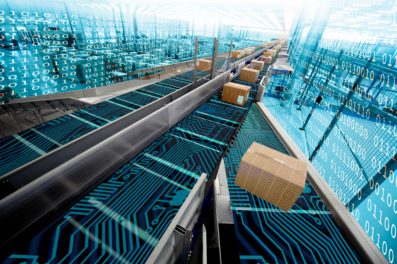BEUMER Group presents data analytics for sortation technology
What are the benefits that big data and data analytics can generate for intralogistics? The system provider presents an intelligent data analytics solution that can be used to examine large amounts of data generated, for example, during sorter operation and visualise the results. With the information collected this way, processes can be optimised, and maintenance measures can be scheduled in advance at an optimum time.
BEUMER Group presents its new BG Sorter Compact CB. This cross-belt sorter features a small design and increases throughput. Among other things, this is ensured by the possibility of data analytics. “With data analytics, we can collect large amounts of data on our sorters and evaluate them in a targeted manner, which then shows us where there is potential for improvement, for example,” explains Thomas Wiesmann, Director Sales Logistic Systems at BEUMER Group in Beckum, Germany. Among other things, the information gained can be used to continuously improve the operation of the system, to identify maintenance requirements at an early stage or to optimise system management. This has a positive impact on product life-cycle costs.
Data analytics enables BEUMER Group to increase the availability and performance of its sorters, keyword “machine learning”. “The decisive factor is continuous access to real-time data from every system area,” explains Wiesmann. With the help of a digital twin, it is possible to monitor material flows or even the routing of the system in every detail. This is supported by the visualisation of results. The operator can use colour codes, for example, to make bottlenecks visible or use time filters to include historical data for the analysis.
Maintenance only when required
With the support of data analysis, it is possible to identify actual operating hours and loads. Thus, maintenance cycles can be adjusted based on the actual load. For example, service personnel will only replace a component when it is really necessary and not according to a fixed cycle.
“Data-driven analysis will continue to increase,” Wiesmann is sure. After all, sensors are already part of every system and able to generate and process huge amounts of data. Based on this acquisition of information, further services may be added in the long term. Wiesmann is thinking of video coding for machine learning. He also envisages cloud-based optical character recognition to convert scanned images with text into machine-readable text.
Where will the journey take us
“Some of our customers already rely on data analytics,” reports Wiesmann. “They use it to reliably monitor their systems and see in time when an error is going to occur. This enables them to maintain their system at the perfect time.” The more intensively a company knows the operating conditions of the system, the better they can benefit from this opportunity. This is because the machine will learn to learn, and instead of just recognising that something is wrong, it will also find out the cause, supported by the information obtained. “This will enable the system to independently generate a perfectly fitting maintenance plan in the future,” predicts Wiesmann.
Data analytics is currently based on existing operational data, but even more sensors and other systems that can collect much more data will be used in the future. The sorter will then be able to continuously make processes smarter and increase the level of automation. A clear competitive advantage for every plant operator.














